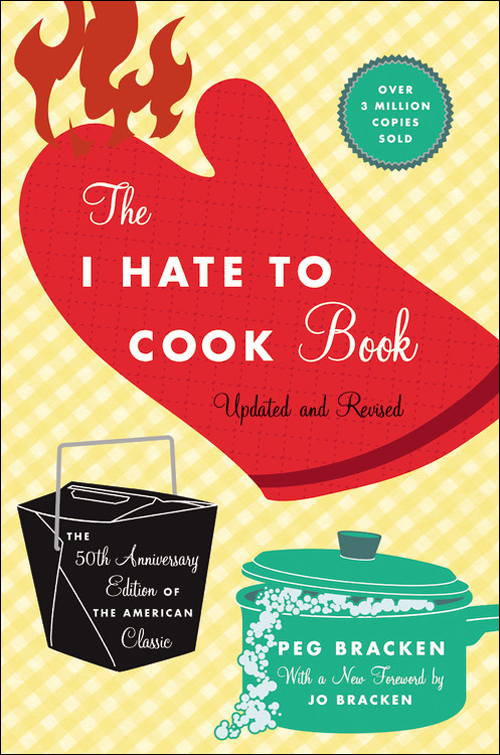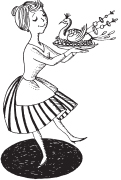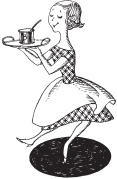The I Hate to Cook Book


Original Work Copyright © 1960 by Peg Bracken
50th Anniversary Edition Copyright © 2010 by Johanna Bracken
Foreword Copyright © 2010 by Johanna Bracken
All rights reserved. Except as permitted under the U.S. Copyright Act of 1976, no part of this publication may be reproduced, distributed, or transmitted in any form or by any means, or stored in a database or retrieval system, without the prior written permission of the publisher.
Grand Central Publishing
Hachette Book Group
237 Park Avenue
New York, NY 10017
Visit our website at
www.HachetteBookGroup.com
.
www.twitter.com/grandcentralpub
First eBook Edition: July 2010
Grand Central Publishing is a division of Hachette Book Group, Inc.
The Grand Central Publishing name and logo is a trademark of Hachette Book Group, Inc.
ISBN: 978-0-446-56894-4
This new edition is dedicated to
John Ohman,
the love of my mother’s life.
What can I say, except thank you?
—Jo Bracken
Contents
3. Vegetables, Salads, Salad Dressings
OR BALLAST IS A GIRL’S BEST FRIEND
OR HOW TO BRING THE WATER FOR THE LEMONADE
OR WAIT TILL YOU TASTE MAYBELLE’S
PEANUT BUTTER ASPIC
8. Canapés and Heartburn Specials
OR THEY ONLY CAME FOR THE BALLOONS
OR THIS IS THE STORY OF YOUR LIFE
OR WHAT TO DO WHEN YOUR
CHURN PADDLE STICKS
OR DREARY DETAILS THAT YOU CERTAINLY HAVE
NO INTENTION OF REMEMBERING
W
hen my mother wrote
The I Hate to Cook Book
in 1960, hers was a world with too few hours, not enough days, and never enough time. To handle the demands of being a full-time writer, full-time mother, and full-time wife, she wrote from 4 a.m. to 9 a.m., a habit she continued long into her “golden years,” as she laughingly called them.
My mother passed away in October of 2007. (And oh, how she would hate for me to use that phrase. Using two words where one would do, let alone not being direct in one’s dialogue, was not something my mother could bear. I can hear her now: “Johanna, don’t beat around the bush. I died. Just say so!”) Little did she know when she left this world and entered the next that while much has changed, those things that truly gave birth to the concepts in her book are still much the same as those our mothers faced in 1960.
True, you may now find your husband doing the cooking as often as you’ll find yourself in the kitchen (that is certainly the case in my house). And thanks to my PDA, and MP3 and DVD player, I can now do four things at the same time (and feel guilty that I’m not giving any one of them my full attention). But while we have seen some amazing advancements over the last fifty years
in computers, science, medicine, and a host of other areas, the one thing we have not been able to accomplish is adding more hours to our twenty-four-hour day. That, and the cure for the common cold, continue to elude even the best and brightest among us!
Writing the foreword to this anniversary edition of
The I Hate to Cook Book
was one of the most difficult things I have ever done. First, I am not a professional writer (my hat is off to anyone who decides to follow in the footsteps of his or her parent’s career) and second, for the first time in my life, my mom wasn’t there to proofread what I’d written. So I thought: What can I share with you about my mom? And the result is this foreword.
The I Hate to Cook Book
was born from a group of professional women who would have been much happier sipping martinis with their husbands than spending the cocktail hour in the kitchen, slaving over a hot stove. These friends decided to share their pain (and surefire recipes) with the hope that they could get back at least a portion of that cocktail hour (and keep their families from going on strike at the same time). Two hundred recipes and a good number of Household Hints later,
The I Hate to Cook Book
went to press.
My mother never thought of herself as a cook, though she was, in fact, a great one. She saw herself as a poet and a humorist who just happened to fall into cooking. The reason
The I Hate to Cook Book
is as timely now as it was in 1960 is because, simply put, it will make you smile, it will make you laugh, and you can do that while whipping up a meal that your family will enjoy and still find time to run a few miles or enjoy that glass of wine while you watch the sun set.
When this book was originally published, there was not a lot of concern about the use of butter and cream in recipes, unless the concern was that it had been left
out
by mistake! In the 1960s you didn’t hear people discuss their arteries at dinner parties. Discussion often centered on what of brand of cigarette to buy, not on
the evils of smoking. So while butter, cream, and sour cream will be found in many (okay, most) of the recipes, you can certainly replace them with milk, yoghurt, low-fat sour cream, or a butter substitute—if you must. Or, as with Chicken-Rice Roger, a recipe I have undoubtedly made once a month for a good part of my life, you can leave the butter out altogether, and no one will be the wiser.
My mother had the utmost respect for those she called “good cooks who like to cook.” Her famous phrase about them was “Invite us over often, please. And stay away from our husbands.” But Mom told me regularly she was just thankful
she
didn’t have to be one. And while age has taught me great appreciation for my mother’s cooking, growing up the daughter of “The I Hate to Cook” lady had its trials and tribulations. There was, of course, continual recipe testing, not only for her nine books but also for her newspaper and magazine columns, as well as testing other peoples’ recipes. And naturally, I had my favorites: Stayabed Stew, Chicken-Rice Roger, Sweep Steak, Lovely Lamb Shanks, Skid Road Stroganoff. There was the embarrassing moment of sitting with friends, watching television, when my mother’s television commercial came on with her friendly but heavily Missouri accented “I’m Peg Bracken, and I hate to cook” line, and I attempted to disappear into the folds of the couch. And of course there was the continual barrage of questions: Is your mom a good cook? What’s it like to have a famous mother? (“Gee, I don’t know. Why don’t you ask someone who does?” was my usual response.) But with my mother’s fame came an unexpected guest in our home: vegetables, of the frozen variety.
Through the eyes of a now-fifty-four-year-old, who would be a better spokesperson for frozen vegetables than my mother, the woman at the forefront of getting women out of the kitchen as quickly as possible? Birds Eye hired my mother as their spokesperson because their products were much like my mother’s recipes:
quick and tasty items you would have in your freezer (much like the ingredients for the
I Hate to Cook Book
recipes) for any last-minute meal decisions. But in the eyes of a then-twelve-year-old who envied her friends’ white bread sandwiches (yes, I had wheat) and iceberg lettuce salads covered in ranch dressing (at my house, it was romaine with only enough oil and vinegar to kiss each leaf), a new frozen vegetable delight every night was inexcusable. Throw some tuna and curry into frozen creamed onions, bake it, and voila—dinner? Spinach Surprise with Portland Pilaff?
Really
, I thought, just who was she trying to kid?
Fortunately for me, my mom, a notorious animal lover since birth, had given in to my nonstop whining for a dog, and as soon as we settled into our scenic northern California home, found an oversized canine to join us: Ralph, our Saint Bernard.
Being an “eat it first, ask questions later” kind of dog, Ralph loved most vegetables. Those he didn’t like somehow found their way into a napkin, which was then tucked into the cushion of the dining chair to be removed at a later time. I’d like to think that Ralph, like most wonderful household pets, helped keep the peace in our home, as my mother did not accept much complaining on my part when I saw a new frozen vegetable surprise on my plate. More than once my mother’s rejoinder rang in my ears: “Just be quiet and eat it. It’s going to put you through college.” And sure enough, they did! More than eighteen commercials (Ralph and I even made a cameo in one) certainly assisted in covering the cost of college tuition, even in the 1970s.
As all mothers do, mine passed on to me words of wisdom that I not only remember but often quote to this day. Two in particular have stuck with me and have now become a part of my closest friends’ memories as well. The first: Be careful what you say, because once you say it, you can never take it back. My mother was a true believer that people talk too much, and if we would all just stay quiet once in a while, the world would be a much better place.
Even so, my mother was one person you would absolutely want at a dinner party. Mom was at her social best when seated at the dinner table, enjoying the company of old or newfound friends. And if she felt the conversation needed a little pick-me-up or if her guests didn’t know each other very well, she thoroughly enjoyed throwing in a conversation starter, such as:
• If you could eat only one food for the rest of your life, what would it be? Mom’s fluctuated between doughnut holes and dark chocolate, though she always added that your beverage of choice (hers, a gin martini) shouldn’t be considered food and therefore could also be added (mine: artichokes and a perfect Manhattan).
• If you could speak to anyone, alive or dead, who would it be? Mark Twain, my mother’s favorite author, was always high on her list.
My mother lived to the age of eighty-nine, her life blessed with great health, loving family and friends, a husband and daughter who adored her, and a razor-sharp wit. She was also an amazingly humble woman who did not realize just how many friends and fans she had in the world, despite the wonderful letters and e-mails that came throughout her life from women whose lives she had so greatly affected. And because she had no idea, neither did I.
One day, shortly after my mother died, I was going through papers and drawers—and another box of Kleenex—when the phone rang. The woman asked for my mother. “I’m sorry,” I said. “She recently passed away.” There was a long pause, and the voice at the other end said, “Oh my gosh, I have been meaning to call her for a year, and time got away from me. Now I can’t tell her how she saved my life!”
She couldn’t tell my mom, but she could—and did—tell me.
So did the many wonderful cards from women my mother had never met and yet whose lives she had influenced with her ability to see and use humor to get through life’s daily struggles.
Oh, the second wisdom my mother passed on to me? When something is finished, let it go.
So with that, I wish you tasty, belly timber dinners made from items easily stored in your kitchen cupboard, decorated with a sprig of parsley on the side. Most of all, I wish you some good laughs and a feeling that finally, someone understands you, along the way.
—Jo Bracken
 Introduction
Introduction